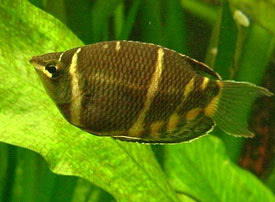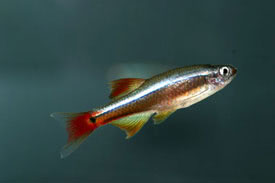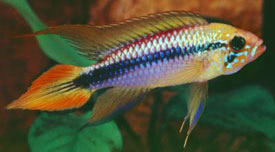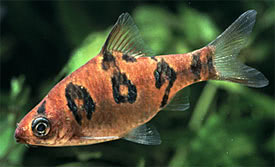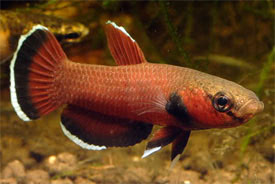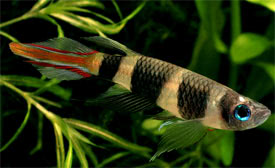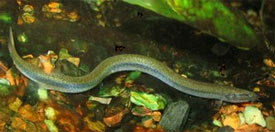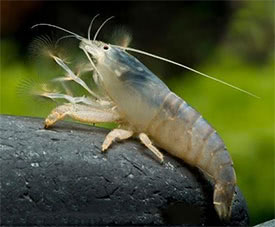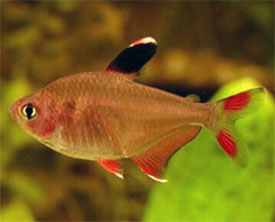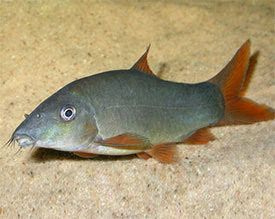
 Magyarul / Hungarian
Magyarul / Hungarian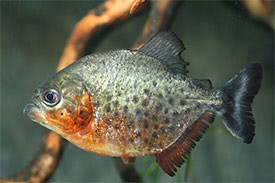
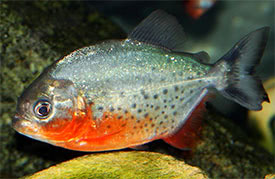

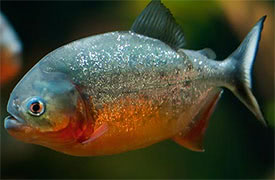

- Scientific name: Pygocentrus nattereri
- Synonyms: Rooseveltiella nattereri (Kner, 1858), Pygocentrus altus (Gill, 1870), Serrasalmo ternetzi (Steindachner, 1908), Pygocentrus ternetzi (Steindachner, 1908), Serrasalmus ternetzi (Steindachner, 1908)
- Common name: Red Bellied Piranha
- Group: Characins
- Distribution: South America; Brazil, Ecuador, Peru, Bolivia, Guyana, Venezuela, Paraguay, Uruguay, Argentina; Amazon basin
- Size: 25-35 cm
- Biotope: Found in larger rivers, streams, lakes, and floodplains.
- Social behavior: A dangerous shoaling fish, although adults do not tend to prey on much smaller fishes. They should be kept in a species-only aquarium.
- Diet: Carnivorous; In the nature they eat live fishes, aquatic invertebrates, insects, and even fruits, sometimes they prey on sick animals or scavenge carcasses. In the aquarium they feed on earthworms, prawn, river shrimp, and fish flesh.
- Breeding: Hard
- Tank: Minimum 600 litres
- Population: 5-6 fish for 900 litres
- Decoration: Use river sand as substrate and decorate the tank with roots, tree branches, and aquatic plants, but leave plenty of open space for the fish to swim. The lighting should be dimmed. It is important to change 30-50% of the tank volume each week, as they eat a lot, and typically produce a lot of waste.
- Temperature: 24-28 °C
- pH: 5.5-7.5
- Hardness: 2.0-12.0 dGH
- Lifespan: 10-12 years
Females generally reach a larger adult size and have a more-rounded body shape than males.
Wild populations exhibit two annual reproductive seasons, the first at the beginning of the wet season, when water levels are rising, and the second during the low water period during November and December, when there is a sudden temporary increase in water level. They usually spawn in the flooded areas among the marginal vegetation. Pygocentrus nattereri is relatively easily to breed in the aquarium, they reach sexual maturity at around a year of age when the fish are 10-15 cm in length. They can be bred in a large aquarium. The best method is to buy a small group and allowing pairs to form naturally. Spawning can be initiated with large, cool water changes. Males become territorial during spawning. The breeding pair will separate from the group and start to create a pit in the substrate where the female lays the eggs. The pit will be about 4-5 cm deep and about 15 cm across. Both the male and the female coloration become darker during spawning. The nest is guarded by the male, sometimes assisted by the female, but usually after 24 hours the male will chase away the female too. In very large aquaria multiple pairs can spawn simultaneously. The number of the golden colored eggs can vary between 500 to 1000. The eggs will hatch in 2-3 days, and the fry become free swimming on the fifth day. When we take away the eggs to hatch and raise them in a separate tank, the male will often spawn again within 2-3 days with another female from the group. The eggs can be separated from the adults with a glass sheet or they can be siphoned into smaller aquarium to hatch artificially. The fry can be fed with newly hatched brine shrimp in the first days. The fry are cannibalistic, so they should be separated by size after a month. From the third moth they can be fed with chopped fish meat.
https://en.wikipedia.org/wiki/Red-bellied_piranha
https://www.seriouslyfish.com/species/pygocentrus-nattereri/
http://www.waza.org/en/zoo/choose-a-species/fishes/bony-fishes/pygocentrus-nattereri
https://www.fishbase.de/summary/Pygocentrus-nattereri.html
https://www.arkive.org/red-bellied-piranha/pygocentrus-nattereri/
http://animal-world.com/encyclo/fresh/characins/RedPiranha.php





